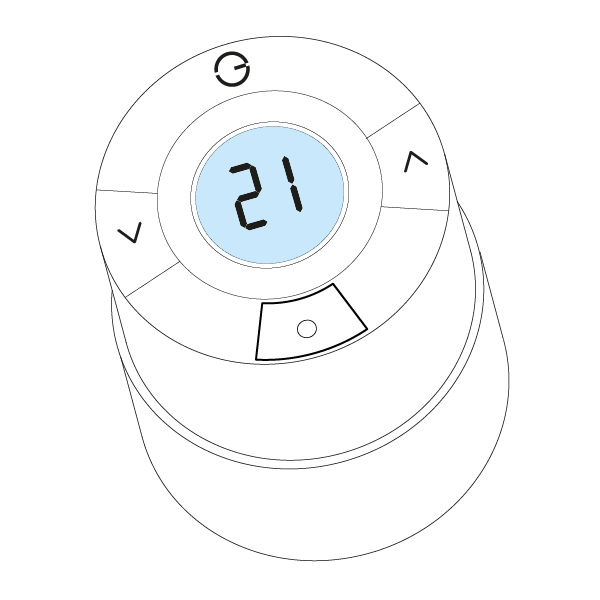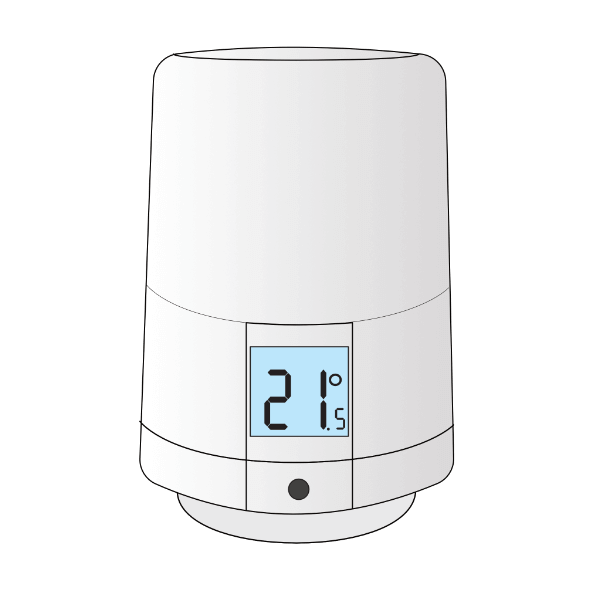eThe Genius Radiator Valve is slow to respond within the first week of installation
WRV-C | WRV-D |
The basics
Things are slightly different depending if you have the newer WRV-E or the older WRV-C when it comes to the responsiveness of the communication, but when it comes to the speed that the valve changes once it has the new target temperature both valves are pretty much the same.
The WRV-C
These valves are asleep all of the time, this is normal. They have to be because the batteries will last two years. They are programmed to wake up every 7.5 minutes to talk with the Genius Hub and then they go straight back to sleep again - it's a tough life being one of the older style Genius Radiator Valves! If you make a change on the app and then immediately go to the valve it may take up to 15 minutes for the valve to get this change. If you press a button on the valve then they normally get the new temperature immediately, as you have just woken the valve up and if it is in direct range of the hub then the hub will tell it the new temperature to go to.
The WRV-E
These valves are awake all of the time and it can pick up the new target temperature as soon as the setpoint in the room changes, the batteries will also last 2 years because these valves use a newer and more advanced communication technology (Zigbee), so this valve should change the setpoint on the screen when you press the button on the valve within about 2 minutes of you changing it on the app.
In all cases
The reason for a valve's slow reaction time in the first week is because of the 'valve learning'. The Genius Radiator Valve does not know what position to go to be able to give you very accurate control of the temperature of the room, and it needs to learn this. Each time a valve is put into 'mount mode' it starts this learning again.
More detail
There are 1,000 steps in the electronic valve from the fully closed position to fully open, and it needs to learn about how the radiator responds when it opens. The first few times you set a temperature on the app for the valve to control to, it will use this as an opportunity to learn.
The valve will open 5 steps every 60 seconds and measure the temperature of the water (through the valve pin), if there is no a change in temperature of the pin it knows that it needs to open a little more. It does this every minute until it senses a change in temperature of the pin, and it stores this position for next time. This process can take up to 45 minutes, so it can take up to 45 minutes for room to warm up during the first week. Learning this makes the valve very fast to respond once they have learned about the radiator and also helps conserve the battery life, as the valve goes straight to the right position it knows it needs to control to.
Some times the valve will try and learn on its own in the first week, even when you have not set a temperature on the app. So don't be alarmed if seemingly randomly a radiator gets warm and then cool again during the first week of the system being installed, or when a valve has been mounted on a radiator, this is just the valve learning.
This makes it extremely accurate and quiet when controlling to a set point temperature in normal operation, and as the valve body wears (the part that the water flows through) the Genius Radiator Valve will be continuously learning and adjusting its position to compensate for this.
General operation
The Genius valves are designed to be as efficient with the heating as they can be. This means that radiators will not be as hot as they were with the old mechanical Thermostatic Radiator Valves (TRVs) on them.
The reason for this is it is much more efficient to heat a room up and then maintain that temperature during the time that it is used, than it is to raise it too much and then let it cool right down and do this repeatedly during the time that the room is occupied. An old manual TRV uses a piece of wax that expands when it gets hot (or sometimes a liquid or gas) and this controls the amount of water that goes into the radiator and how hot the room gets, the wax is very slow to respond, so inevitably the room will overheat at which point the manual TRV valve fully shuts off and the room will cool down too much, then it opens fully again and overheats the room, and this cycle happens repeatedly during the course of the room being heated. This 'hysteresis' is both uncomfortable and also not efficient.
The Genius Valve is designed to warm up a room and ensure that it does not overheat, and then maintain a very stable temperature. On the app you can check this by looking at the historical charts for any individual room.
Because the Genius Valve does not want to overheat the room it means that radiators will sometimes take a little longer to warm up and then will not be as hot as they used to be. The reason for this is if the Genius Valve were to open fully when it is only trying to heat the room by 3-4º then it would likely overheat the room, and this would not be efficient. You will also notice that when the room is close to the target temperature the radiator will feel 'lukewarm', and this is because it is now maintaining the temperature in the room and it does this by letting just the right amount of heat into the room by throttling back the radiator.
If you want to have the heating on for short periods of time as you feel this is more efficient for your boiler, you will need to set much higher temperatures in your schedules (for example 28º) so the radiator gets hot (as it will open fully at this temperature generally) and put as much heat into the room as it can in a short a period as possible. This is not what the valve is designed to do but it works if you would prefer to heat your rooms this way.
You can optimise the system the way you want it to, also by seeing the tips on this page about how the valve can be made to work harder for your boiler: How the Genius Radiator Valve controls the temperature accurately
After the first week
See these tips for fine-tuning your Genius Hub system: Adjustments you can make with our Genius Hub Devices to fine tune your setup
If the Genius Valve is behind a piece of furniture or thick curtains then it is likely not to experience the correct temperature for the room, so you can change the valve hidden offset to compensate for this: Genius Radiator Valve Offset Temperature
See this explanation of the valve learning if it takes much longer than you expect or continues on more than a week: Genius Radiator Valve taking a long time to warm up - outflow side of the plumbing.

